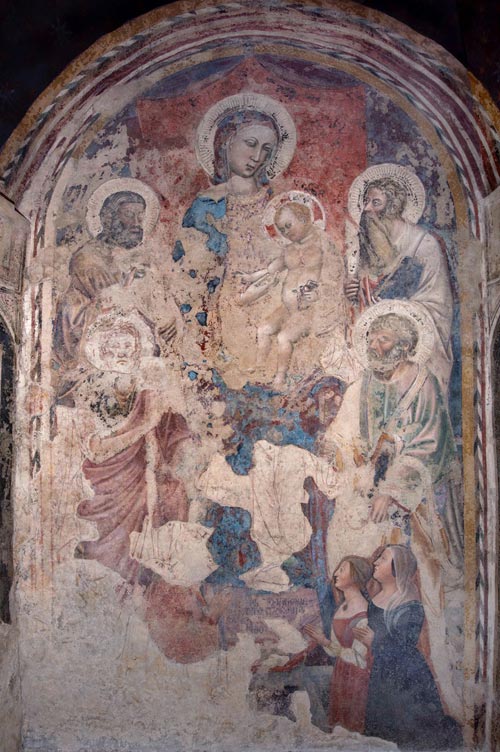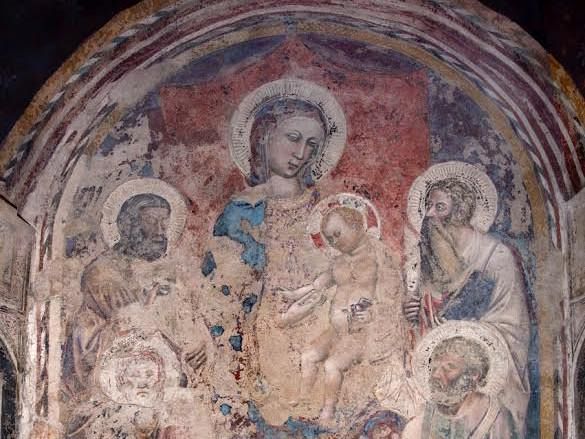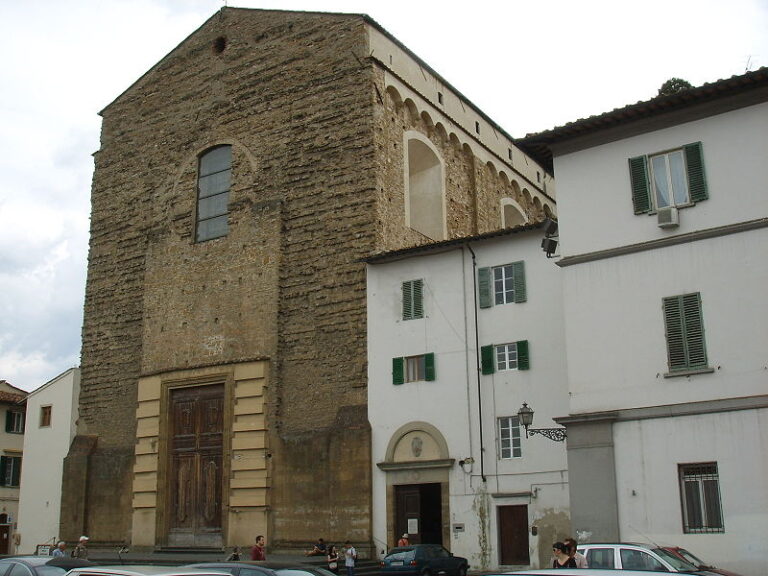Piazza del Carmine
corner of Piazza Piattellina
corner of Piazza Piattellina
the tabernacles of florence
THE TABERNACLE
Madonna col Bambino
The painting depicts the enthroned Madonna and Child, accompanied by Saints Filippo (or Andrea: both in fact have the cross as their iconographic symbol), Giovanni Battista, Bartolommeo and Pietro. In the somewhat deep funnel of the aedicule, two other figures find their place: on the right San Giorgio the Knight slaying the dragon and on the left a saint in monk's (or friar's) habit, leaning on a staff, variously interpreted as Andrea da Anagni or Gherardo da Villamagna. Lower down, belonging to a different hand and era than the sacred figures, two female figures are depicted kneeling, hands joined, as they direct their gaze and prayers to Our Lady and the infant Jesus. The two women, given their different ages (and also the different clothing: more severe in the figure on the left, more casual in the one on the right, as befits an unmarried young woman) can be identified as Niccolò Borgherini's wife and daughter.
Tabernacle
The tabernacle is set into the exterior wall of the former Rospigliosi Pallavicini Palace, now owned by the Franciscan Missionary Sisters of Mary.
THE STREET
Piazza del Carmine
It was formed in 1330, like other similar large city squares, to allow crowds to attend Carmelite sermons. In fact, the basilica of Santa Maria del Carmine is located here. It is considered one of the main squares in the Oltrarno district.
AUTHOR
Master of San Martino a Mensola
He was a lively painter of the second half of the 14th century, who took his conventional name from the polyptych, dated 1391, preserved in the church of that name in the Florentine hills below Fiesole. We owe to Luciano Bellosi the suggestive hypothesis that this author should be identified with a certain Francesco di Michele.
The artist
However, the artist's style, which in the physiognomies of the figures appears savory and pungent, according to Rosanna Proto Pisani "shows an energetic language open to the stylistic novelties and naturalistic expressions of the late international Gothic period with tangents to a painter like Gherardo Starnina.”
Curiosity
On the throne step, at the level of the women's faces, is the inscription, "NICOL[A]VS DE BORGE/RINIS CT. AN[NO] SA[LUTIS] [M CCCC]LX[X]XX[...]," which reveals the identity of the commissioner of the late 15th-century addition and who is probably also effigyed below, on the left: but of this undoubtedly male figure only the bust and hand are preserved in fresco, while the lines of the face can be traced in the sinopia on the plaster below. The addition was made at the hands of a painter of the Garlandesque style, less idealized and more adherent to the real thing.
GALLERY

Tabernacle: Fresco
Piazza del Carmine corner of Piazza Piattellina

Fresco's detail
Piazza del Carmine corner of Piazza piattellina

Basilica of Santa Maria del Carmine
Piazza del Carmine



